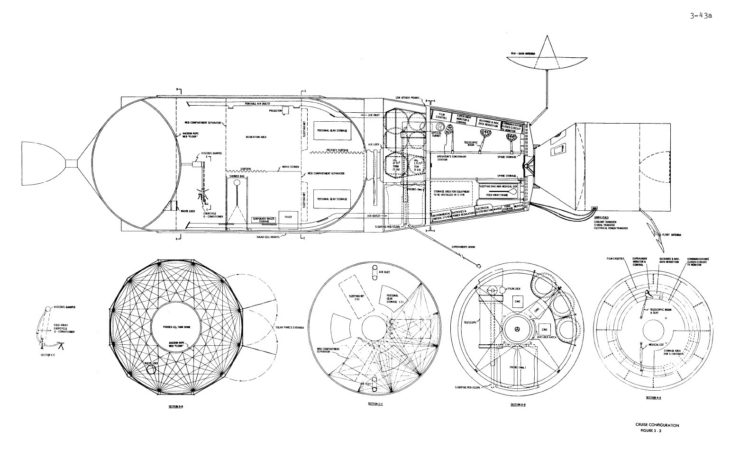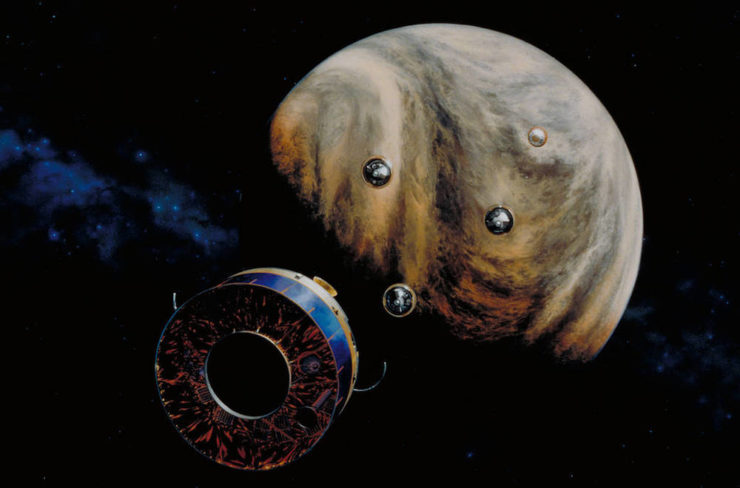Many readers may find the plots of some SF novels deeply implausible. “Who,” they ask, “would send astronauts off on an interstellar mission before verifying the Go Very Fast Now drive was faster than light and not merely as fast as light? Who would be silly enough to send colonists on a one-way mission to distant worlds on the basis of very limited data gathered by poorly programmed robots? Who would think threatening an alien race about whom little is known, save that they’ve been around for a million years, is a good idea?”
Some real people have bad ideas; we’re lucky that comparatively few of them become reality. Take, for example, a proposal to send humans to Venus. Not to land, but as a flyby.
After the Apollo program had landed humans on the Moon, the obvious question was, “What next?” Some proposals were carried out: Skylab space station; U.S.-Soviet cooperation in orbit. Other proposals were binned because there was no money for such things or because they were obviously stupid.
The Manned Venus Flyby would have been both expensive and stupid.
The mission would have re-purposed Apollo-era equipment for a far more ambitious journey. Rather than a week or so in space, the astronauts would have spent more than a year on a slow cruise past Venus. Rather than expect the astronauts to spend this time in the cramped conditions of a Command Module and LEM, the Manned Venus mission would have converted a hydrogen tank into living quarters once it had served its original purpose and was no longer filled with liquid hydrogen. The interplanetary vehicle that resulted would have been quite impressive even by modern standards, let alone those of the Apollo era.

Of course, the mission was not intended to land on Venus. If you could get down to the surface (or what passes for a surface on Venus) you couldn’t get back up to the spacecraft. Venus is nearly as massive as Earth and its escape velocity is not much lower. Without in-situ resource utilization, the fuel demands for an Earth > Venus’ surface, Venus > Earth mission would have been intractable.
Not to mention the fact that Venus is a hell planet. The lower reaches of its dense poisonous atmosphere are hot enough to melt lead. Sending astronauts down to the surface would merely have tested how close to the surface they could get before the ambient conditions killed them.
Happily, that was not what was proposed.
Instead, the astronauts would have been sent on a flyby that would last from late October of 1973 to early December of 1974. The encounter with Venus would have occurred in early March 1974. While close to Venus, the astronauts would collect a wide variety of data about that world and its interplanetary neighborhood (which includes Mercury). They would also give the U.S. a reason to wave the flag and boast of achieving the first interplanetary manned mission. USA! USA!
If I sound unappreciative of this bold plan, you are right. I think it’s cockamamie. Because:
The mission does not do anything robotic missions could not do more cheaply. While humans are a lot more flexible than machines, they’re difficult and expensive to feed and protect. Not only do you need to pay for the fuel to toss humans across space, you need to pay for everything needed to keep them alive as well. Note that what we have actually done is send robots to explore Venus and Mars, as well as other worlds.
(But, you say, we would learn so much about how to feed and protect crew, which we cannot do without crewed missions. Hey, we’re still working on keeping humans alive on space stations safely below the Van Allen belt. That’s enough for now.)
An even more important reason why the Manned Venus Flyby would have been a bad idea (even if Congress had been inclined to fund it—which it was not) is that the interplanetary environment was more challenging than folks in the ‘70s understood. The Apollo-moon-mission-era solution to spacecraft radiation shielding was to hope very, very hard that no major solar storm would occur on the way to and from the Moon. As it turned out, this worked—which is good because a major storm would have definitely killed the Apollo astronauts. Hoping for good space weather would have been a no-go for a four-hundred- day mission, so a Manned Venus Flyby would have required a radiation shelter, yay. What the proposers could not have known, however, is that their mission would have run into a coronal mass ejection in July 1974, one major enough to overwhelm any currently implementable shelter. This would have been fatal for the astronauts.
While this would at least have provided a distraction from Watergate, President Nixon probably wouldn’t have found it pleasant to explain to the press just how the U.S. lost a crew in deep space.
So the next time you set down a science fiction novel and think “nobody would be dumb enough to send people off on an obvious one-way trip to certain death”, just remember that at one point in recent history, sending a collection of astronauts off to be crisped like KFC chicken seemed like a reasonable idea.
In the words of Wikipedia editor TexasAndroid, prolific book reviewer and perennial Darwin Award nominee James Davis Nicoll is of “questionable notability.” His work has appeared in Publishers Weekly and Romantic Times as well as on his own websites, James Nicoll Reviews and Young People Read Old SFF (where he is assisted by editor Karen Lofstrom and web person Adrienne L. Travis). He is a finalist for the 2019 Best Fan Writer Hugo Award, and is surprisingly flammable.










